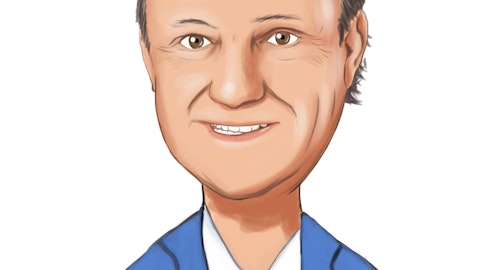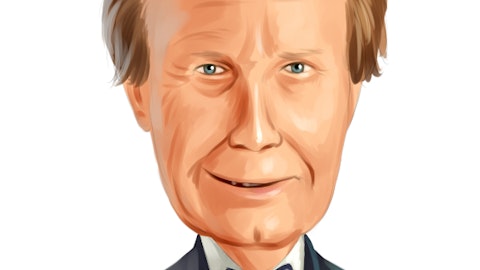Bryan Bergin: Okay, that makes sense. And I guess as you think that organic versus inorganic, is it relatively even-mixed according to the long-term strategy as you think about that ’24 view?
John Pence: I think so. It’ll be lumpy, right. It’s not perfectly linear. So, you’re never going to see this line up 100% even, because we will spike it once in a while with an acquisition. But I do think it’s — when I think about it, I do think it is a pretty healthy mix of both.
Pat Goepel: Yes. And we had really good visibility to double-digit organic growth. So, we will — more reasons we did the raise is we want to get aggressive with inorganic growth. And we feel like we have a pipeline of some pent up demand. So, while it might be lumpy, there’s pretty good certainty on the revenue, going forward.
Bryan Bergin: Okay, very good. And if I could just squeeze one more in, can you just comment on how client employment levels trended in the quarter?
Pat Goepel: Really about flat, it’s interesting, small businesses still have more jobs than people. And there are certain industries that cannot get people hired, and even today. What I would say is there is a little bit of a white-collar recession. And there’s pressure on that higher end. But I would say, in small business, we’ve had a mixture of some of pressure around the technology area and some of the higher-end employment. But I would say that blue-collar employment or in the areas of restaurant, in the areas of even trades, they can’t get enough people. So, the overall hiring has been about flat. And seasonally, we would have expected maybe a little bit of an increase, but clearly there is a want there to hire more employees if they can get them.
Bryan Bergin: Okay. Thank you.
Operator: Our next question is from the line of Richard Baldry with ROTH MKM. Please proceed with your questions.
Richard Baldry: Thanks. Can you talk about the M&A pipeline, and it seems to be factored in for ’24. Are you seeing reasonableness in what sellers are looking for, and the interest levels to take action on it, and just any sort of characteristics around that? And then maybe given we took down a lot of the debt in the quarter, when you look forward, what kind of terms or structures are you really trying to focus on? Would be a lot less on the debt side and more on the cash and stock? How do we think about that in terms of equity dilution? Thanks.
Pat Goepel: Yes, Rich, lot of questions in that question. So, I’ll try to unpack and John will jump in as well. But when I think about, first of all, the environment of small business payroll companies, the environment is pretty tough. First of all, regional banks have stopped lending. So, access to capital is the number one concern, two the payroll industry in general is getting regulated more and more by state money, money transmitter licenses. KYC, which is Know Your Customer, AML/BML, which is anti-money laundering, et cetera, so small businesses have a tough time keeping up legislatively. They have a tough time keeping up with the changing landscape of the laws. They have tough time keeping up with capital needed. And in some cases of ACA, some of the banks are requiring deposits that are tough to fund especially if debt levels are tough to get.
So, the backdrop is that what I would say is also when you think about how they’re going to grow their business and what they look like and interest rates going up, very often they might be looking for a different exit strategy at this point in time to counter what they’re going through. And we’re a logical exit strategy for them. So, we’ve had some conversation over the last couple years we get with our resellers and we get with our trusted partners a couple times a year. And many times, you can telegraph that early on. We did a subsequent acquisition that we put as an extension of the Q in October already. We do believe we have a pipeline as far as multiples, the multiples are reasonable and feel that they’re starting to pull in given the backdrop.
And then, people are worried about potentially a recession or potentially a slowing down of the economy. So, we think it’s the right time to continue to grow. And then, for us, we’ve been purposeful about, kind of growing this business and calling out it’s a scale business. The operational and technology initiatives that we’ve done to improve the bottom line and really grow margin here 10% over the last couple of years we’re ready to handle that volume. And so, many cases, luck is preparation meeting opportunity. We feel it’s really a good time to go and be aggressive here. And the passing of ERTC has given us a catalyst as well to do that. So, those are some of the things of how we think about it. And then, as far as your last question around lending or cash or stock, for us, we have three levers.
We have cash, we have a seller note, which is important to us because it’s a low cost note and it protects us on indemnification. And from a stock perspective, only if we feel that the acquisition could add value to us long-term when we look at stock. Look, we also have a little over $30 million in cash and feel that we have the ability to make some acquisitions. We do think the lending market over time will be more reasonable than it is. So, that’s a lever that we could add. But some kind of cash, stock and indemnification of a low-cost loan will continue to be our model.
Richard Baldry: And maybe flipping back to organic, you posted up, I think it was 26% increase in bookings on top of 91% a year ago. You talk just generally about average 10 years sort of capacity, you feel like your utilization is or what’s left, can you continue to grow? Or do you think you really have to focus more on adding headcount to try to keep up the organic growth now? Thanks.
Pat Goepel: Yes, thanks Rich. And we are adding from 100 sales reps to 120. And one of the reasons we’re adding is, we got people successful. We’re going to have over 50% of them at the summit that we have would say that, that’s a record number for us that are going to go to the summit and they’ve been successful. The training program we put together, the hiring of people we’ve been able to attract really good, what I’ll call athletes. And to Asure, they’ve been successful, we also have a culture of mentoring. And it’s done a really good job bringing people into the organization. So, there’s going to be no slowing down of continue to grow. And then, as you look at the model and we’ve improved margins here, almost double margins the last couple of years, because we’re starting to get scale, we want to not only invest in our talent, but then also add more.
And we believe that as we add more and get the more gross dollars, not only from productivity, but new people and the quality of the new people that adds to the bottom line. So, it’s a multi-year commitment, but we feel really strong about it and we’re fortunate to be in a position to be able to do that.




